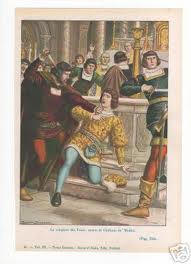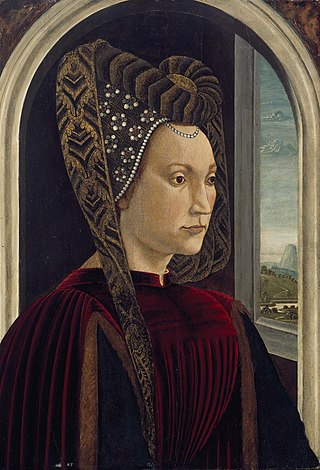Related Research Articles

Lorenzo di Piero de' Medici, known as Lorenzo the Magnificent, was an Italian statesman, banker, de facto ruler of the Florentine Republic, and the most powerful and enthusiastic patron of Renaissance culture in Italy. He was a magnate, diplomat, politician and patron of scholars, artists, and poets. As a patron, he is best known for his sponsorship of artists such as Botticelli and Michelangelo. He held the balance of power within the Italic League, an alliance of states that stabilized political conditions on the Italian peninsula for decades, and his life coincided with the mature phase of the Italian Renaissance and the Golden Age of Florence. On the foreign policy front, Lorenzo manifested a clear plan to stem the territorial ambitions of Pope Sixtus IV, in the name of the balance of the Italian League of 1454. For these reasons, Lorenzo was the subject of the Pazzi conspiracy (1478), in which his brother Giuliano was assassinated. The Peace of Lodi of 1454 that he supported among the various Italian states collapsed with his death. He is buried in the Medici Chapel in Florence.

The Pazzi were a powerful family in the Republic of Florence. Their main trade during the fifteenth century was banking. In the aftermath of the Pazzi conspiracy in 1478, members of the family were banished from Florence and their property was confiscated; the family name and coat-of-arms were permanently suppressed by order of the Signoria.

Giuliano de' Medici was the second son of Piero de' Medici and Lucrezia Tornabuoni. As co-ruler of Florence, with his brother Lorenzo the Magnificent, he complemented his brother's image as the "patron of the arts" with his own image as the handsome, sporting "golden boy." He was killed in a plot known as the Pazzi conspiracy.

The Pazzi conspiracy was a failed plot by members of the Pazzi family and others to displace the Medici family as rulers of Renaissance Florence.

Girolamo Riario was Lord of Imola and Forlì. He served as Captain General of the Church under his uncle Pope Sixtus IV. He was one of the organisers of the failed 1478 Pazzi conspiracy against the Medici family, the rulers of Florence, and was assassinated 10 years later by members of the Forlivese Orsi family.

I Medici is an opera in four acts composed by Ruggero Leoncavallo, with a libretto by the composer. Set in Renaissance Florence at the court of Lorenzo de' Medici, it was intended as the first part of a planned but unfinished trilogy called Crepusculum. The opera premiered on 6 November 1893 at the Teatro Dal Verme in Milan.

Francesco de' Pazzi was a Florentine banker, a member of the Pazzi noble family, and one of the instigators of the Pazzi conspiracy, a plot to displace the Medici family as rulers of the Florentine Republic. His uncle, Jacopo de' Pazzi, was one of the main organizers of the conspiracy.
Francesco Salviati Riario was the archbishop of Pisa from 1474 to 1478. He was one of the organisers of the Pazzi conspiracy, a plot to displace the Medici family as rulers of the Florentine Republic; he was executed after the failure of the plot.

Clarice Orsini (1453–1488) was the daughter of Iacopo Orsini, and his wife and cousin Maddalena Orsini both from the Orsini family, a great Roman noble house and was the wife of Lorenzo de' Medici.

Jacopo III Appiano, VI Lord of Piombino was an Italian nobleman.

The palleschi, also known as bigi, were partisans of the Medici family in Florence. The name derived by the Medici coat-of-arms, bearing six 'balls' (palle).
Bernardo Bandini Baroncelli was an Florentine merchant and a protagonist in the Pazzi conspiracy, a plot to remove the Medici family from power in Florence.

Jacopo de' Pazzi was a Florentine banker who became head of the Pazzi family in 1464, and the younger child of Andrea de' Pazzi and Costanza de' Bardi. He commissioned Palazzo Pazzi between 1462 and 1472. Stefano di Ser Niccolo da Bagnone served as a secretary to Jacopo and tutor to his daughter Caterina. He was killed alongside his nephews Francesco and Renato after the failed Pazzi conspiracy, which was a plot to remove the Medici family from power in Florence.

Antonio Maffei da Volterra was an Italian presbyter, clergyman, and Papal notary. He was born into a noble family in the town of Volterra, then part of the Florentine Republic ruled by the Medici family. He is best remembered for the role he played in the Pazzi conspiracy, a plot to remove the Medici from power by those dissatisfied with their rule. On Easter Sunday, 26 April 1478, Maffei and other conspirators attempted to assassinate Lorenzo de' Medici and his brother Giuliano inside the Santa Maria del Fiore cathedral in Florence. Together with fellow conspirator Stefano da Bagnone, Maffei tried to strangle Lorenzo and managed to wound him in the throat. However, while Giuliano was successfully killed, Lorenzo survived his injuries. After the failure of the assassination plot, Maffei found refuge in the Badia Fiorentina church in Florence, but was later arrested and hanged from the Palazzo della Signoria on 3 May.

Andrea di Guglielmo de' Pazzi was an Italian politician of Republic of Florence, known for having commissioned the Pazzi Chapel from Filippo Brunelleschi and for being the father of Jacopo de' Pazzi and the grandfather of Francesco and Guglielmo de' Pazzi.

Guglielmo di Antonio de' Pazzi, Lord of Civitella was an Italian nobleman, banker and politician from the Republic of Florence. He was also husband of Bianca de' Medici, sister of the Lord of Florence Lorenzo the Magnificent.

Renato di Piero de' Pazzi was an Italian politician and banker by Republic of Florence, who died in the riots that followed the failure of the Pazzi conspiracy against the Medici family.

Caterina di Jacopo de' Pazzi was an Italian blessed, and daughter of Jacopo de' Pazzi, creator of the Pazzi Conspiracy.

Francesco Nori was a Florentine banker. During the Pazzi assassination attempt of 1478 he protected Lorenzo de' Medici, saving his life at the cost of his own.

Semiramide Appiano was an Italian noblewoman, daughter of the Lord of Piombino Jacopo III Appiano and wife of Lorenzo di Pierfrancesco de' Medici. She was the granddaughter of the famous Simonetta Vespucci, Botticelli's muse.
References
- 1 2 3 4 Garfagnini, Gian C., ed. (1994). Lorenzo il Magnifico e il suo tempo: convegno internazionale di studi; (Firenze, 9-13 giugno 1992). Atti di convegni / Istituto Nazionale di Studi sul Rinascimento. Firenze: Olschki. p. 114. ISBN 978-88-222-3973-0.
- 1 2 "La congiura dei Pazzi". Palazzo Medici Riccardi (in Italian). Retrieved 2023-06-09.
- ↑ ""Io confesso di aver voluto uccidere Lorenzo il Magnifico"". la Repubblica (in Italian). 2023-04-24. Retrieved 2023-06-09.
- ↑ "Page 6 | Assassin's Creed II - La Guida Completa". Eurogamer.it (in Italian). 2021-05-17. Retrieved 2023-06-09.